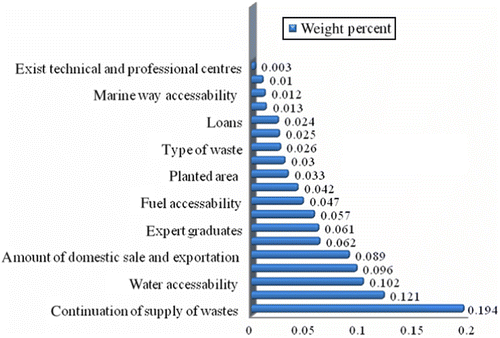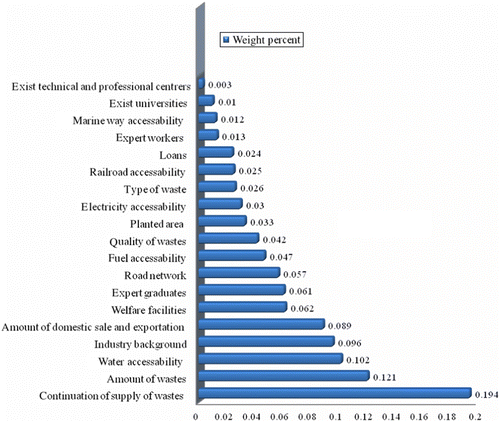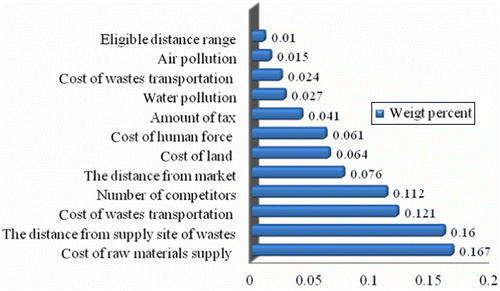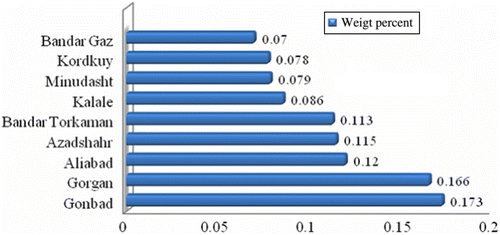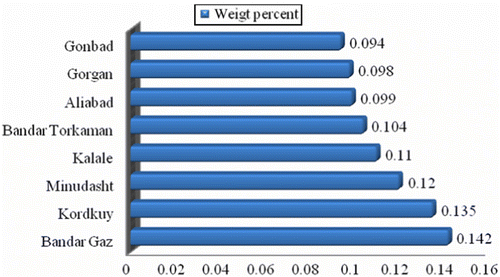Abstract
Today, the issue of site selection for industrial units in developing countries which are poor in wood resources is considered as a vital matter and it is one of the key measures in the process of building industrial and giving service units. In every country there are some provinces and states which are more useful than other parts owing to primary infrastructures and facilities for industrialisation. As one of the suitable provinces of Iran, thanks to its lignocelluloses resources with 1,822,696 tons of exploitable waste, Golestan Province has a very good potential for building lignocelluloses products mills, such as fluting paper. For this end, in 2010, effective indices in fluting paper mill establishment were recognised in Golestan Province. Results showed that materials and products were the most important main indices and the preparation cost of raw materials was the most important sub-index. Finally, questionnaires were prepared for the best site selection and choices were evaluated according to the structure of interests and costs. The results of calculations performed through analytical hierarchy processes and in Expert Choice Software indicated that Gonbad City had the highest interest/cost ratio, and therefore, it is the best place for the establishment of floating paper mills from agricultural wastes in Golestan Province.
1. Introduction
Today, the issue of site selection of industrial units in countries which encounter restriction of use of resources and facilities is considered as a crucial matter. Considering the lack of resources of wood production in the world (3.4 and 3.34 billion m3 in 1994 and 2003, respectively) and increase in demand and wood consumption in recent years, site selection and determination of optimal geography for wood and paper mills are the main concerns of many countries, especially developing countries with low jungle covering, e.g. Iran (Abolfathi and Hamedinejad Citation2008). During last years, Jungles and Pastures Organisation of Iran has severely reduced the exploitation of industrial jungles in the northern part of the country, and on this basis, wood supply for new paper and carton mills is completely abolished and industries and mines are more restricted. Ministry of Iran does not issue permissions for establishment of new mills that are based on the use of these raw materials. Thus, by utilising the available capabilities in the case of using other lignocellulosic raw materials instead of wood in new and establishing industries, several serious attempts should be done to obtain fibres from agricultural resources (Tajdini et al. Citation2007).
Salient growth of the population in developing countries which are poor in wood resources and increasing demand for various types of products from cellulose resources perforce reflect a brilliant future for the use of non-woody resources and agricultural fibres. And fortunately, annual rates of use of non-woody plants for the production of paste and paper is higher compared to wood, especially in developing countries (Teimouri and Nikandish Citation2008). So, through internal need for importing this raw material, some policies should be made in order to lead to independence and lower dependence on other countries. One avenue for independence is a correct planning for optimal use of existing resources and facilities according to capabilities of various areas. The next step is to recognise the capabilities of various areas and correct site selection for these mills (Forghani, Gilkolayeh, and Nasiri Citation2009).
Golestan Province is the northern part of Iran with 720,460 km2, and its neighbours are provinces such as Semnan, Mazandaran and Northern Khorasan, and Turkmenistan. Respectively, owing to its special geographical location, it has a moderate climate and is agriculturally very fertile. Besides due to its climate (proper weather, e.g. temperature and relative humidity) along with rich and fertile soil which provides valuable agricultural conditions, many agricultural products such as cotton, canola, wheat, sunflower seed, corn and barley are cultivated and also some of the agricultural products like wheat are cultivated and harvested two times a year.
The average production of exploitable agricultural wastes all around the country, between 2002 and 2005, is estimated around 24,208,566 tons from which 1,822,696 tons (7.53%) are from Golestan Province. Also, it is known that Golestan Province, with 25.9% growth in production of wastes during 4 years (2002–2005), has a very suitable potential to utilise agricultural wastes in the production of lignocellulose products (Madhoushi et al. Citation2008). Besides, owing to the fact that Gilan and Mazandaran provinces have the highest rate of precipitation as well as relative humidity that can limit the cultivation of some agricultural products and on the other hand, providing the best condition for rice cultivation in Iran, it can be said that rice production in Iran merely belongs to these provinces. Since rice is more valuable and expensive than most of the mentioned agricultural products in Iran, almost all of the usable lands (most of the areas of Gilan and Mazandaran provinces are surrounded by forests and Caspian Sea) are cultivated merely with rice.
Due to its extensive lignocellulose resources, Golestan Province is one of the agricultural poles and selected sites for this industry. Recognising areas of the province with the best situation for establishment of floating paper mill with agricultural pastes is in a great importance and if they are economic, technical and local issues in establishing of mill are considered and this mill can grasp a significant success in competitive production.
Jesuk (Citation2005) made use of analytical hierarchy process (AHP) for resolving the problem of site selection for distributing facilities in Korea. In this study, a comprehensive decision-making model comprising five indices and 20 sub-indices has been presented, and the results of assessment have been analysed on the basis of site selection.
Partovi (Citation2006) applied three processes, namely quality function deployment, AHP and network analysis, for site selection and strategic facilities. This study is aimed at describing a novel analytic method for site selection of facilities.
The current study aims to outline an optimal site selection for a floating paper mill from agricultural wastes in the Golestan Province and tries to answer the following question: ‘which city of Golestan Province has a higher capability for establishment of floating paper mill?’, by accepting the hypothesis that Gorgan has the highest priority for establishment of the mill due to its high capacity for investment attraction and more facilities, followed by other cities that have a lower priority rating.
2. Research methods
2.1 Analytical hierarchy process
The AHP is a decision-making technique for managing problems involving multiple criteria and multiple conflicting objectives. The AHP engages decision-makers in breaking down a decision into smaler parts, proceeding from the goal to criteria to sub-criteria, down to the alternative courses of action. Decision-makers then make simple pairwise comparison judgements throughout the hierarchy to arrive at overall priorities for the alternatives. This approach provides the structure and the mathematics for helping decision-makers make rational decisions. A rational decision is one of the best achievements of the multitude of objectives of the decision-maker(s) (Saaty Citation1990). The three basic principles of AHP are: Hierarchy Representation and Decomposition, Priority Discrimination and Synthesis and Logical Consistency (Saaty Citation2000). The first step in the AHP is to decompose the problem into a dominance hierarchy. The top-most level represents the goal of the problem. Intermediate levels are the criteria or sub-objectives, in which lower levels depend. As many levels as necessary can be used. The lower levels act as the criteria or factors contributing to the level immediately above. This type of assessment is usually made by paired comparisons responding to an appropriately posed question eliciting the judgement. The mathematical definition of a hierarchy is given in Saaty's book (Saaty Citation1990). The assessment procedure consists of a pairwise comparison through the hierarchical structure to derive a priority matrix for each level of the structure. The final step involves applying the weights to the measured factors to derive a ranking on the critical attributes to support each application. The AHP provides a ranking scale to assess the importance of each technical dimension to each class of applications. These dimensions are ranked from the fundamental 1–9 scale presented by Saaty to represent the ratio (Saaty Citation2000). Setting priorities in a hierarchy requires that we perform measurements throughout the structure. We must then synthesise these measurements to obtain priorities for the bottom level. The AHP is based on the ranking activities in terms of relative ratio scales. In the paired comparison approach of the AHP, one estimates ratios by using a fundamental scale of absolute numbers in comparing two alternatives with respect to an attribute and one uses the smaller value as the unit for that attribute. To estimate the larger one as a multiple of that unit, we assign to it an absolute number from a fundamental scale. This process is done for every pair. Thus, instead of assigning two numbers w
i
and w
j
and forming the ratio w
i
/w
j
, we assign a single number drawn from the fundamental 1–9 scale to represent the ratio (w
i
/w
j
): the absolute number from the scale is an approximation to the ratio w
i
/w
j
. The derived scale tells us what the w
i
and w
j
are. Let w be a matrix (Equation (Equation1)) whose row elements are ratios of the measurements w
i
of each of n items with respect to all others.
One of the main advantages of this method is its use in group decision making, in such a way that it will integrate the group members' decisions, so that the final and optimised decision contains the decisions of all members (Memariani and Azar Citation1995).
2.2 How was the questionnaire prepared?
First, effective indices in optimal site selection for the production of floating paper from agricultural wastes were recognised through experts, academics and producers' points of view and through library studies. These indices were divided into six groups, namely ‘supply of materials and product’, ‘infrastructural’, ‘environmental’, ‘rules and regulations’, ‘economic’ and ‘technical and human’, and 31 sub-indices were placed within these six groups. The number and distribution of the experts who responded to the questionnaires were 100 and they included university professors and lecturers, college students, industrialists and people involved in wood and paper industries. Three series of questionnaires were designed as follows:
| 1. | First-type questionnaire: pairwise comparison of indices and sub-indices: after drawing hierarchy of the mentioned indices and recognition of their different levels, a questionnaire was designed for pairwise comparison of indices and sub-indices and their effectiveness level (weight of indices) where viewpoints of experts about importance level of these indices and sub-indices for each other have been caught. | ||||
| 2. | Second-type questionnaire on the basis of structure of benefits and costs: in second stage of the study, the indices were divided into two groups, namely positive indices and negative indices, and a questionnaire was designed so as to understand the level of importance of the indices and prioritising them. | ||||
| 3. | Third-type questionnaire: in this questionnaire, different parts of the province are analysed and interpreted in terms of effective indices in site selection for floating paper mill. Then, suitability of the different areas of the province was known in terms of these indices and finally, sensitivity analysis and interpretation were performed in terms of weighted value of different indices of the study through AHP. | ||||
Table 1 Fundamental scale of absolute numbers corresponding to verbal comparisons.
Table 2 Choices of the province.
For prioritisation of the choices, indices were divided into benefits and costs. The choices were once subjected to pairwise comparisons against benefits. Then, the choices were subjected to pairwise comparison against costs as well, and prioritisations of the choices were calculated in terms of indices of benefits and costs. Through calculation of benefit/cost ratio (B/C) for each choice, the choice with the highest ratio is considered as the superior choice. Wedley, Ung Choo, and Schoner (Citation2001), with respect to the aspects of benefits and costs after determining criteria and sub-criteria regarding AHP, presented the criteria and sub-criteria which are divided into two groups as benefits (positive factors) and costs (negative factors) until they do not deactivate their effects.
3. Results
3.1 Effective indices weight in site selection for fluting paper mill from agricultural wastes
Effective indices weight in site selection for floating paper mill from agricultural wastes and the results obtained from pairwise comparisons in experts' viewpoints, which have been calculated by using AHP and its software Expert Choice, were presented in two areas, namely (1) main indices and sub-indices, and (2) prioritisation of choices on the basis of structure of benefits and costs.
3.2 Results of prioritisation of main indices
The results obtained from the first-type questionnaire show that in site selection for a floating paper mill from agricultural wastes, ‘supply of materials and product’ is ranked first with 0.311 points, and ‘economic’, ‘infrastructural’, ‘environmental’, ‘rules and regulations’ and ‘technical and human’ indices have priorities with 0.283, 0.207, 0.088, 0.057 and 0.055, respectively (see Figure ).
3.3 Prioritisation of choices
In this stage of the study, pairwise comparison matrix of choices in terms of positive and negative indices were separately formed and the data obtained from the second-type questionnaire, which is associated with pairwise comparison of the indices, were used. Also, for prioritisation of the choices in terms of the indices, the third-type questionnaire was applied. The charts were obtained as follows:
Prioritisation of positive indices (benefits) (see Figure ).
| |||||
Prioritisation of negative indices (costs) (see Figure ).
| |||||
3.3.1 Prioritisation of choices in terms of positive indices (benefits)
Prioritisation of the choices in terms of positive indices is as follows: Gonbad, Gorgan, Aliabad, Azad shahr, Bandar Torkaman, Kalaleh, Minoodasht, Kordkuy and Bandar-Gaz with 0.173, 0.166, 0.120, 0.115, 0,113, 0.086, 0.079, 0.078 and 0.070 weights, respectively (see Figure ).
3.3.2 Prioritisation of choices in terms of negative indices (costs)
Prioritisation of the choices in term of negative indices is as follows: Kalaleh, Bandar-Gaz, Minoudasht, Kordkouy, Bandar-Turkmen, Aliabad, Azadshahr, Gorgan and Gonbad with 0.142, 0.135, 0.120, 0.110, 0.104, 0.101, 0.099, 0.098 and 0.094 weights, respectively (see Figure ).
3.3.3 Final prioritisation of choices in terms of B/C
In order to find the best choice, each choice should be obtained in terms of the ratio of positive indices to negative indices (B/C). The choice with the highest value is the best choice. The results of prioritisation of the choices on the basis of AHP show that Gonbad is the best choice for establishment of a floating paper mill in the Golestan Province (Table ), thanks to its higher B/C.
Table 3 The results of positive indices to negative indices ratio.
4. Discussion and conclusion
4.1 Prioritisation of the choices in terms of structure of positive indices (benefits)
According to the results, Gonbad (0.173) was proposed as the best choice. Five priorities of positive indices are respectively as follows: certainty of supply of raw material, amount of raw material, availability of water supplies, industrial background, and domestic sale and exportation. On the basis of the results obtained, prioritisation of indices and selection of the best choice are completed as follows.
4.1.1 Certainty of supply of raw material and amount of raw material
Extent of agricultural products such as wheat and barley, in Gonbad is higher than other parts (Madhoushi, Hashemi Khebreh, and Kamkar Citation2008). Then, placement of this city among the other six cities is a positive point that leads to transportation of raw material having a lower cost and a shorter time. So, supply of raw material can be assured more through building big and safe silos using lower costs (Azizi Citation2005). Certainty of supply of raw material sub-index has been proposed as an important priority in the site selection for plywood and coating unit. Modarres and Asefvaziri (Citation1990) mentioned the closeness to raw material, sufficiency of available raw material and quality of raw material as the most important sub-criteria regarding the factor of raw material.
Ghasemian, Khlili Roodkhani, and Aliabadi (Citation2008) presented procurement of proper cellulosic raw material as an important criterion and remembered that it will be a struggle in the field of the pulp and paper industry of the country and in the world. Bayat Kashkooli, Azizi, and Nazerial (Citation2008) showed that the amount of raw material in location selection of factories of wood industries is a main factor of decision-making.
One of the major challenges to achieve the goal is supplying raw material for the industry. In the past years, Forests and Range Lands organisation of Iran has extremely constrained the use of industrial foresting in the north. This amount was reduced from 1.34 million m3 in 2000 to 920 thousand tons in 2004 (Arian Citation2005). Hejazi, Nemati, and Goli (Citation2004) identify that the availability of raw material is one of the important effective parameters in the location selection of industrial units. Michael, Teitel, and Ranskog (Citation1998) have shown that purchasing costs of raw materials is very important in location selection of industrial units.
4.1.2 Water availability
Considering presented plans by the Industries and Mines Ministry of Iran for the units with an annual capacity of 2000 tons, annual consumption of water for the production line, sanitation and drinking is estimated to be 3500 m3; this amount of water is available in industrial estates of Gonbad through piped water (tap water) resources. Bayat Kashkooli, Azizi, and Nazerial (Citation2008) presented that access to water resources has high priority in the location selection of wood and paper factories.
4.1.3 Industrial background
Factories, such as Gonbad's chipboard factory and floating paper mills from recycled paper, that exist are some samples of the industrial background of this city. Azizi, Amiri, and Modarres (Citation2004) displayed that the industrial background is an effective criterion in location selection of Iranian plywood and factories of veneer industries.
4.1.4 Domestic sale and exportation of product
Due to the proximity to Turkmenistan and existence of exportation terminals, proximity to Incheh-Boroun boundary small bazaar, and also proximity to the capital of the province and contiguity to two provinces, namely Semnan and Northern Khorasan, Gonbad has a higher prioritisation than other cities of the province. Burdurlu and Ejder (Citation2003) determined the factors influencing site selection for furniture industry in Turkey has four main groups in which marketing and amount of sale are very important criteria in the research.
4.2 Prioritisation of choices in terms of structure of cost
On the basis of the results, Kalaleh with 0.142 weight percentage has the highest priority in terms of costs. The negative indices with more priorities are respectively as follows: cost of supply of raw materials, distance of the mill from raw material source, competitors and distance from target market. On the basis of these indices, prioritisation of choices is analysed as follows.
4.2.1 Cost of raw material supply
One of the factors which results in increasing the cost of raw material supply is dispersal of wastes; in Gonbad, the planted area for agricultural products is more than other parts. Also, Gonbad has the same borders with the other six cities of the province. Therefore, raw materials can be taken to the mill at a lower cost and in shorter time. Existence of expert forces in this part is a positive point; they can reduce the costs through their experiences and comprehensive basic education. Michael, Teitel, and Ranskog (Citation1998) introduced the purchase of raw material as an important factor in location selection of secondary wood industries. Bhattacharya, Sarkar, and Mukherjee (Citation2004) in their study for the site selection of a factory proposed that the cost of raw material is a main factor.
4.2.2 Distance of the mill from raw material source
Considering the fact that a large amount of raw material is supplied from inside the area and that Gonbad has the same borders with most cities of the province and the distance to other cities is not very high, the distance from mill to raw material source will be lower in comparison with other cities. Safdari and Nasiri (Citation2009) presented that due to high volume of agricultural residues, there will be a high cost to transfer raw material in long distances and it is necessary to decrease the distance between the factory and agricultural residues.
4.2.3 Competitors
There is a floating paper mill in Gonbad, but considering the fact that this mill uses useless après to produce floating paper, there is no competitor in terms of raw material, and considering the need of the city and country of this raw material, importance of competitors index in terms of sales is low and establishment of the mentioned bill is feasible in this city. Mines and Industries Ministry (Citation2007) announced that the internal production is not enough to fulfil Iran's demand regarding fluting paper, therefore to export the paper, manufacturers have to consider competition prices and quality of the product in world markets. In the field of fluting paper from agricultural residues as raw material price of 1 m2 with 127 g is 4200–4400 rials (http://intl.mim.gov.ir).
4.2.4 Distance from target market
Due to special conditions of Gonbad, such as joint border with Turkmenistan and direct access to this country, existence of a connecting road to Incheh-Boroun border and proximity to the capital of the province, distance from target market in this city is lower than that of other cities. Kotler and Keller (Citation2009) indicated in general, regardless of industry and product type, presence and possibility of access to the market are considered as necessary conditions for establishing a production unit. Accordingly, nonexistence, small size, weakness in tension and finally, being away from the market will cancel the philosophy and the economic justification for any unit or service.
5. Final conclusion
Due to higher B/C, which shows higher importance level of positive indices to negative indices, Gonbad is in the first priority with a weighted value of 0.173, and therefore, it is the best choice for the establishment of a floating paper mill from agricultural wastes in Golestan Province; on the basis of the obtained results, effective indices in site selection for a floating paper mill from agricultural wastes in Golestan Province are ‘supply of materials and product’, ‘economic’, ‘infrastructural’, ‘environmental’, ‘rules and regulations’ and ‘technical and human’, respectively. Among evaluated sub-indices, ‘cost of supply of raw materials’ and ‘certainty of supply of raw materials’ are accounted as the first and second priorities, respectively, and they are the most effective indices in site selection. On the basis of the obtained results, Gonbad was chosen as the best choice because of its highest B/C than other cities.
Additional information
Notes on contributors
Mohammad Vali
1 1. [email protected].Ali Rafighi
2 2. [email protected].Nemat Mohebbi
3 3. [email protected].Notes
References
- Abolfathi , H. and Hamedinejad , A. 2008 . “ Trends of Wood Production and Development of Iran's Wood and Paper Industries in the Previous 5 Decades ” . In The First Iranian Conference on Supplying Raw Materials and Development of Wood and Paper Industries Gorgan University of Agricultural Sciences Natural Resources
- Arian , A. 2005 . Comprehensive Report on Shortage of Wood Required for Pulp and Paper Industry and the Necessity of Removing Obstacles to and Lifting Ban on Timber Imports, the First Section . Iranian Journal of Wood and Paper Industries , 15 ( 1 ) : 21 – 25 .
- Azizi, M. 2005. “Decision Making for Raw Material Procurement in Paper Making Factory.” ISAHP 2005, Eighth International Symposium on Analytic Hierarchy Process, July 8–10, Hawaii, USA
- Azizi , M. , Amiri , S. and Memariani , A. 2003 . Case Study of Plywood & Veneer Industries Choice Location, and Identification of Provinces in Iran, Suitable for Establishment of the Industry . Iranian Journal of Natural Resources , 59 ( 2 ) : 447 – 456 .
- Azizi , M. , Amiri , S. and Modarres , M. 2004 . Decision Making for Suitable Location Selection of Plywood and Veneer Units . Iranian Journal of Natural Resources , 4 ( 57 ) : 523 – 536 .
- Bayat Kashkooli, A., M. Azizi, and M. Nazerial. 2008. “Procument of Raw Material and Development of Wood and Paper Industry in Sistan and Bloochestan Province.” The Iranian First Conference on Supplying Raw Materials and Developing Wood and Paper Industries, Gorgan University of Agricultural Sciences Natural Resources
- Bhattacharya , A. , Sarkar , B. and Mukherjee , S. K. 2004 . A New Method for Plant Location Selection: A Holistic Approach . International Journal of Industrial Engineering , 11 ( 4 ) : 330 – 338 .
- Burdurlu , E. and Ejder , E. 2003 . Location Choice for Furniture Industry Firms by Using Analytic Hierarchy Process (AHP) Method . G.U. Journal of Science , 16 ( 2 ) : 369 – 373 .
- Eddie W.L. , Cheng and Li , Heng . 2001 . Analytic hierarchy process: an approach to determine measures for business performance . Measuring Business Excellence , 5 ( 3 ) : 30 – 37 .
- Forghani , S. , Gilkolayeh , G. V. and Nasiri , F. 2009 . Paper Prepared from Lingo Cellulosic Materials (Agricultural Resources) . Journal of Iranian Natural Resources , 8 ( 49 ) : 82
- Ghasemian , A. , Khlili Roodkhani , A. and Aliabadi , M. 2008 . “ Role of Paper Recycling in Procuring Cellulosic Raw Material of Pulp and Paper Industry ” . In The Iranian First Conference on Supplying Raw Materials and Developing Wood and Paper Industries Gorgan University of Agricultural Sciences Natural Resources
- Giresunlu , M. , Tanritanir , E. and Akbulut , T. 1998 . “ Using of AHP for Location Selection of MDF Industries ” . In 75th Turkey Republicanism Ceremony 612 – 620 . Istanbul, Turkey October 21-23, Istanbul symposium
- Hejazi , S. R. , Nemati , R. and Goli , M. 2004 . “ A fuzzy system for plant location selection ” . In The Fifth Fuzzy Systems Conference of Iran
- Iran Ministry of Industries and Mines web page. (2007) http://intl.mim.gov.ir
- Jesuk , K. O. 2005 . “ Solving a Distribution Facility Location Problem Using an Analytic Hierarchy Process Approach ” . In ISAHP Honolulu, Hawaii
- Kotler , P. and Keller , K. L. 2009 . Marketing Management , 347 – 564 . Upper Saddle River, NJ : Pearson Education International (Prentice Hall) .
- Madhoushi, M., M. Hashemi Khebreh, and B. Kamkar. 2008. “Investigation on the Quantity of Agricultural Wastes of Golestan Province in Order to Use for Its Wood-Plastic Industry.” The First Iranian Conference on Supplying Raw Materials and Development of Wood and Paper Industries. Gorgan University of Agricultural Sciences Natural Resources, Iran
- Memariani , A. and Azar , A. 1995 . AHP: A New Technique for Group Decision Making . Management Science , 28 : 22 – 32 .
- Memariani , A. , Kishore , N. and Naziri , K. 1992 . How to Make Decision in Conflicting Environment: Analytical Hierarchy Process . Udyog Pragati , : 32 – 35 .
- Michael , J. H. , Teitel , J. and Ranskog , J. E. 1998 . Production Facility Site Selection Factors for Texas Value-added Wood Producers . Forest Products Journal , 48 ( 7/8 ) : 27 – 32 .
- Modarres , M. and Asefvaziri , A. 1990 . Feasibility Study of Industrial Plans – Industries Generation Planning , 224 Tehran, Iran : Sharif University of Technology .
- Partovi , F. Y. 2006 . An Analytic Model for Locating Facilities Strategically . The International Journal of Management Science , 34 ( 1 ) : 41 – 55 .
- Saaty , T. and Cho , Y. 2001 . The Decision by the US Congress on China's Trade Status: a Multicriteria Analysis . Socio-Economic Planning Sciences , 35 : 243 – 252 .
- Saaty , T. L. 1990 . Multi Criteria Decision Making: The Analytic Hierarchy Process, Planning, Priority Setting, Resource Allocation , Pittsburg, PA : RWS Publications .
- Saaty , T. L. 2000 . Decision Making for Leaders , Pittsburg, PA : RWS Publications .
- Safdari , V. and Nasiri , F. 2009 . Procurement of Paper from Agricultural Residues . Journal of Wood and Paper , 8 ( 49 ) : 82 – 92 .
- Tajdini , A. , Amiri , S. , Peykani , G. H. , Jahan Latibari , A. and Hamasi , A. 2007 . Introducing a Novel Programming Model for Optimal Establishment of Straw Based Pulp and Paper Plants with Capacity of 75000 tons in Mazandaran Province . Journal of Natural Resources , 11 : 220 – 226 .
- Teimouri , K. and Nikandish , O. 2008 . “ Technical and Economical Investigation of Producing Fluting Paper from Straw in Fars Province ” . In The First Iranian Conference on Supplying Raw Materials and Development of Wood and paper Industries 40 Gorgan University of Agricultural Sciences Natural Resources, Iran
- Wedley , W. C. , Ung Choo , E. and Schoner , B. 2001 . Magnitude Adjustment for AHP Benefit/Cost Ratios . European Journal of Operational Research , 133 ( 2001 ) : 342 – 351 .
